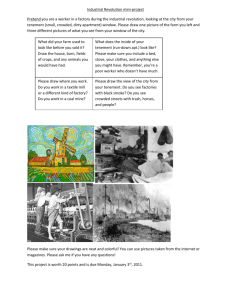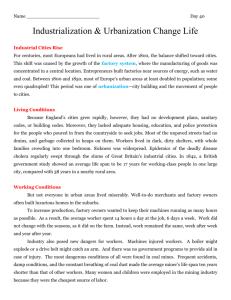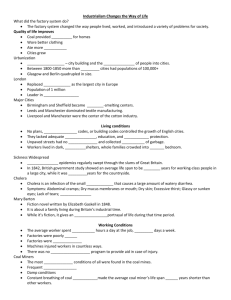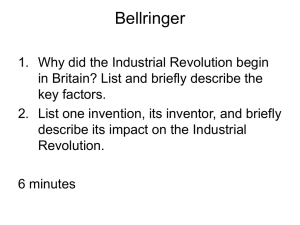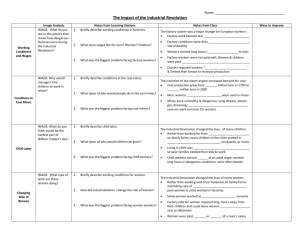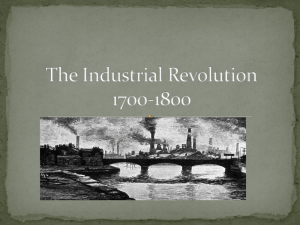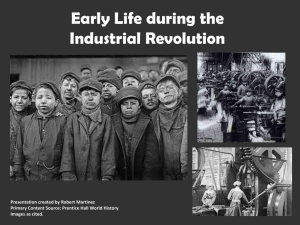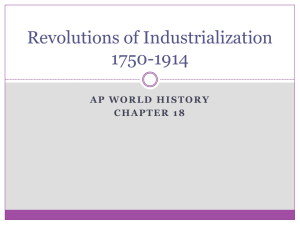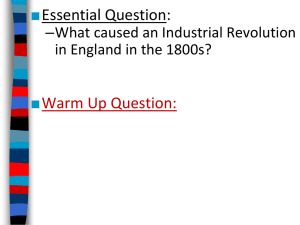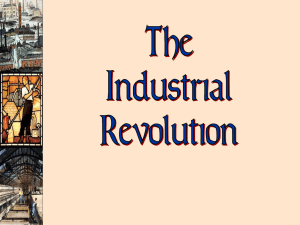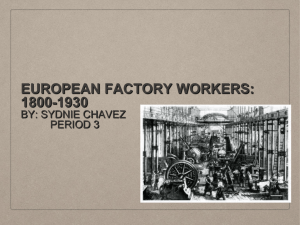Ch7Sec3
advertisement
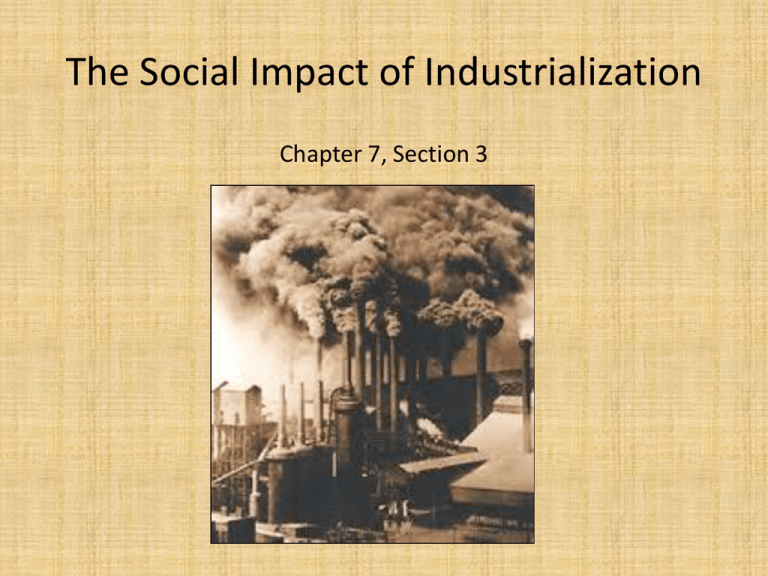
The Social Impact of Industrialization Chapter 7, Section 3 Reasons for Urbanization* • Changes in farming • Soaring population growth • Ever-increasing demand for workers *Do you remember from yesterday what urbanization means? Manchester, England Visitors described the “cloud of coal vapor” that polluted the air, the pounding noise of steam engines, and the filthy stench of its river… 1750: 1780: 1801: 17,000 40,000 70,000 New Social Classes Emerge THE INDUSTRIAL MIDDLE CLASS • The Industrial revolution created a new middle class that were entrepreneurs, merchants, inventors, and artisans. • The new middle class lived in well-furnished, spacious homes. • The wealthy had maidservants to look after their children, and the working class, whose children were a part of the workforce. THE INDUSTRIAL WORKING CLASS • • • Vast number of the population were poor and struggled to survive in foul-smelling slums. Tenements – low-cost, multifamily housing designed to squeeze in as many people as possible. No housing laws meant that landlords didn’t have to adhere to any codes – Considered some of the worst housing ever built in the US – Rooms built for single occupants housed multiple families – Usually had 2-3 rooms (10 feet square) – One room looked out onto the street and one room looked into the airshaft = Bedroom = Living room D D = Hallway Hallway in a tenement Airshaft Airshaft was intended to provide ventilation, but it also doubled as the tenement dumpster! What problems would arise as a result? Room in a tenement, 1910. This family probably lived in this room and possibly one other smaller room Bohemian cigar makers at work in their tenement…home doubles as work site Lodgers in a crowded tenement…how many people are here? Bathrooms & Plumbing • Outhouses in the courtyard • Some would have an indoor bathroom on each floor – Problem: too much use = overflow • Water - outdoor pumps near outhouses – Women washed clothing there – Would carry water upstairs for cooking/bathing As many as 150 people and two shops on the bottom level filled each building. Toilets like this, four per floor, were communal, and were located near and vented into the air shaft that served the inner apartments as their only source of light and air. 1905 photo. Heat • Most had a coal stove in the kitchen • Could get heat from gas pipes - insert coins into a meter Tenement yards were the only place for kids to play, but were also breeding grounds for violence, drunkenness and delinquency In a seven-cent lodging-house The man slept in this cellar for four years, about 1890 WORKERS STAGE FUTILE PROTESTS • Labor Union: workers' organization • Labor unions were illegal at the time, but secret unions did exist among frustrated British workers. • They wanted fair pay, fewer hours, and better working conditions. • Unfortunately, they didn’t have any political power The Luddites First instances of industrial riots in England: 1811 – 1813 Luddites: A group of textile workers began smashing the machines and burning down factories WORKERS FIND COMFORT IN RELIGION • Found comfort in religious movement called Methodism. • This movement was influenced by the Industrial Revolution as people moved to the cities and away from the church. • Movement was started by John Wesley and he stressed the need of personal sense of faith. • The Methodists helped channel the anger away from the revolution and towards the reform. Life in the Factories and Mines The heart of the new industrial city was the factory. The technology of the machine age imposed a harsh new way of life on workers. Factory Workers Face Harsh Conditions • Working in factories was much more difficult than working on the farm. • Working on a farm had limited hours and season. • Working in the factory consisted of long shifts lasting from 12 to 16 hours, six to seven days a week. • Workers suffered from accidents with the machines that had no safety devices. Factory Conditions, Continued… • In textile mills, workers were constantly breathing in air filled with lint that would damage their lungs. • Majority of early factory works were women • Employers often preferred to hire women workers because they thought women could adapt more easily to machines. (They also paid them half as much as men!) • Women would often work 12 hours in the factories then have to go home and tend to their families. Miners Face Worse Conditions • The Industrial Revolution increased the demand for iron and coal. This increased the need for miners. • Miners were paid more, but the work was very harsh. • They worked in darkness and coal dust destroyed their lungs. • The danger was also to an extreme, explosions, flooding and collapsing of tunnels made it really dangerous. • Children and women often pushed heavy coal carts through the tunnels. Children Have Dangerous Jobs •Many boys and girls worked in factories and mines. •Children often started working at age seven or eight, a few as young as five. •They changed spools in the hot and humid textile mills where sometimes they couldn't even see because of all the dust. Children crawled under machinery to repair broken threads in the mills. •In the mines, some children sat all day in the dark, opening and closing air vents. Others hauled coal carts in extreme heat. •Parents accepted the idea of child labor because they helped with work on the farm and the earnings that the children earned were needed to keep their families from starving. Child Labor, Continued… •Child labor reform laws were passed in the early 1800s, called "factory acts." These laws reduced a child's workday to twelve hours and also removed children under the age of eight or nine from the cotton mills. •The laws were generally not enforced so British lawmakers formed teams of inspectors to ensure that factories and mines obeyed the laws. •More laws were passed to shorten the workday for women and require children who work to be educated. Results of Industrialization 2. Wages increased 1. Better wages, hours, working conditions, Suffrage for workingclass males 2. More money for consumer goods 3. Demands for goods grew 4. Railroad costs fell 3. More factories meant more jobs 4. More people could visit other towns 1. Formation of unions Let’s Review! On a sheet of notebook paper, number from 1 to 7. REVIEW: 1. What caused the growth of cities during the Industrial Revolution? a. growing demand for farmers b. creation of a new middle class c. unsanitary conditions d. need for factory workers 2. Those who benefited most from the Industrial Revolution were: a. entrepreneurs. b. women and children. c. former farm workers. d. the industrial working class. 3. Luddites, who smashed machines in Britain, were groups of: a. rural workers. b. textile workers. c. miners. d. missionaries. 4. Why did the factory owners often prefer to hire women? a. women were highly skilled. b. women worked harder than men. c. women did not need health benefits. d. women could be paid less than men. 5. What was one hazard of working in textile factories? a. darkness b. explosions c. air filled with lint d. low ceiling 6. In the 1830s and 1840s, British inspectors made sure that: a. textile quality was high. b. mines were safe. c. Methodism was followed. d. labor laws were followed. 7. One positive effect of the Industrial Revolution was: a. a drop in workplace injuries. b. a drop in employment. c. a rise in wages. d. better mass-produced goods.

